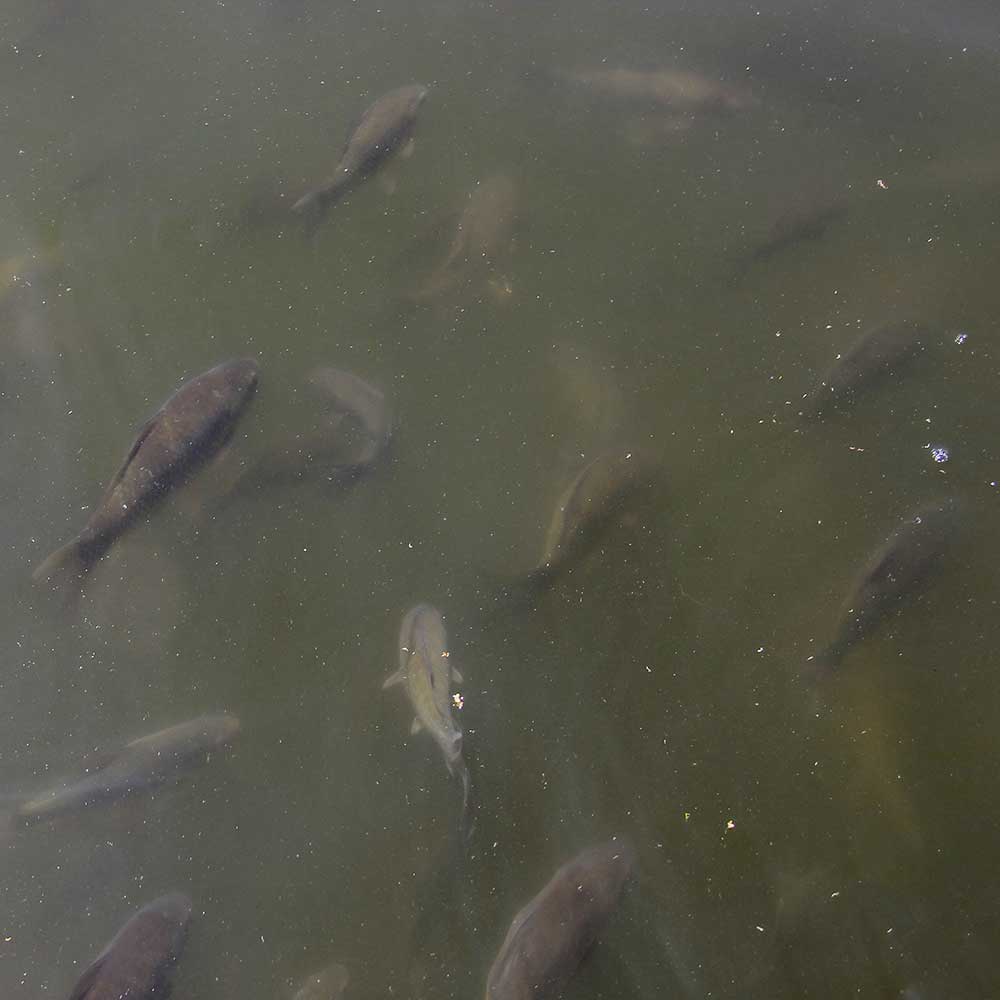Is your pond cloudy, muddy, or murky brown? If so, you may be dealing with water turbidity. This lack of clarity can be attributed to different factors, so we’ll cover what causes turbidity and how you can fix it in your pond here.
Turbidity Defined
Turbidity describes liquid that is cloudy due to suspended particles and measures relative clarity by how much light can pass through a water sample. Turbidity is most commonly seen in ponds with soft clay bottoms or where erosion and runoff are prevalent.
A pond is considered turbid if you cannot see past the top two feet of water. Beyond an unattractive appearance, turbidity blocks sunlight and lowers dissolved oxygen levels, which can harm fish and other aquatic life.
What Causes Turbidity?
Many disparate organic and inorganic factors can contribute to water clarity issues. In some areas, the chemical makeup of the water and soil may not mix well, and fine silt and clay particles never settle. Weather can also affect pond turbidity, especially storms with heavy rain and wind.
Turbidity can also result from animals causing erosion and agitating the water. Cattle enjoy a good dip, and ponds are a great water source, but livestock wandering into the water can directly cause turbidity. It’s the same story with aquatic wildlife like muskrats, large flocks of ducks or geese, catfish, buffalo fish, carp, and other creatures that root along the bottom and constantly kick up sediment.
Excessive nutrients and phosphates can lead to organic water turbidity issues. Phosphates enter a pond or lake from decaying vegetation and storm runoff, which introduces fertilizers and other contaminants. This debris decreases clarity and feeds algal blooms, which multiply and obscure the water even further.
How to Reduce Turbidity in Pond Water
Diagnose It With a Jar Test This is an important first step in determining the root cause of your turbid pond and whether the sediment will settle when left undisturbed. It’s simple to do: dunk a clear glass jar into your pond, fill it with water, cap it, and keep it in the dark. We recommend letting your jar sit for about a week to see the full results. After a week, retrieve the jar and observe the water from the top down and the side.
Bind Phosphates: If your water remains murky and cloudy during the jar test, it may indicate high phosphate levels. Farm runoff, lawn fertilizers, and animal waste are the primary contributors to extremely high levels of phosphates. Thankfully, treatment is easy with a clarifier or flocculant for ponds, like Airmax EcoBoost PRx. This highly effective, all-natural phosphate binder works within the water column to clear up cloudy or murky water and restore water quality.
Control Environment Factors: If the water clears during the jar test, your pond is turbid because of environmental factors. You will need to determine what those factors are and if you can control them. If you have determined that your murky pond is due to excessive erosion, you can plant marginal grasses to control erosion, wind, and storm runoff. If creatures are causing problems, you can remove or adjust livestock access, add predator fish to control an overpopulation of foragers, or deter undesirable wildlife with decoys.
Add Gravel & Bottom-Growing Vegetation: If you have determined that suspended clay is causing turbidity in your pond, you can take steps to keep the pond sediment in place at the bottom. Consider adding stones or pea gravel and allowing Chara and other plants to take root. The addition of gravel and plants will help settle your pond bottom and clear the water.
A Few Final Tips:
Contact your local Department of Natural Resources for information on soil and water issues in your area. Ask if there are water testing opportunities. If there is an agricultural extension office near you, they might have additional resources and testing options available.
DO add aeration to your pond. Turbid ponds have lower oxygen saturation, harming plant and animal life. Adding oxygen with aerator pumps will boost beneficial bacterial activity, which may increase water clarity.
DO use the Airmax ClearPAC Plus after the pond settles to clean, clear, and balance the water and reduce excess nutrients that may be left behind from a formerly turbid environment.
DON’T use hay or straw, as they increase your nutrient load and may lead to harmful algae growth. The exception is Barley Straw, which produces a clarifying compound as it breaks down. Ensure you remove bales of barley straw before they fully decompose.
DON’T treat too fast, as rapid water adjustments can negatively affect oxygen saturation and kill fish.
Even the best treatment may be temporary in some ponds, especially if turbidity is due to inorganic sediment and environmental factors. If you have worked to address the root cause of your turbidity and taken proactive treatment steps, your efforts will be more effective.
Water Clarity Treatment Tips
If your pond is still a murky mess, you probably need additional help. Contact us online or call 866-POND-HELP, and one of our friendly pond experts will gladly help you!
Ready to learn more about water clarity in ponds and lakes? Check out the following related articles:
Water Clarity Study With PondClear
Phosphate Control Study With EcoBoost PRx
Cloudy Water in Summer, Clear Water in Winter
How to Do a Jar Test
Is the Scum on the Pond Pollen or Algae?
Last Updated: May 20, 2024
